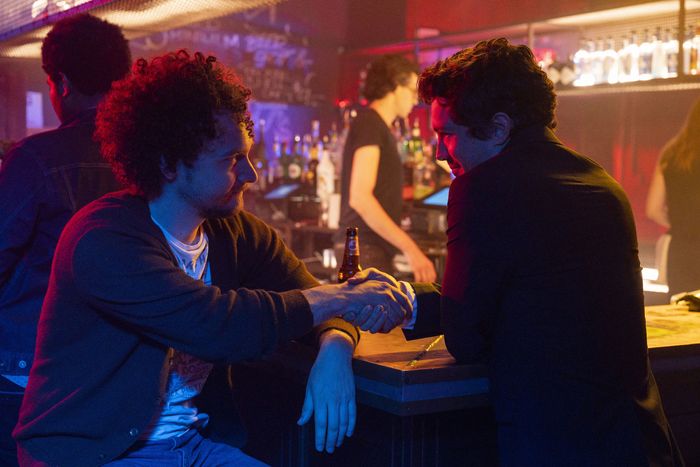
One of the fundamental truths of great TV storytelling is that all shows should have at least one stand-alone episode, and that has never been more clear than for two of February’s most interesting new shows. On Apple TV+, there’s Mythic Quest: Raven’s Banquet, a workplace sitcom from the It’s Always Sunny in Philadelphia team about video-game developers that’s easily 50 percent better than its title makes it sound. On Hulu, there’s High Fidelity, a TV adaptation of the Nick Hornby novel and John Cusack movie about an obsessive record-store owner who reconnects with exes. Each show has a solid set of protagonists, a well-established rhythm for how its episodes tend to work, and plenty of compelling story for its main set of characters. And each show is better because for one episode in the season, it abandons those things to tell a story about someone else entirely.
There are lots of variations of the stand-alone episode: bottle episodes, musical episodes, silent episodes, episodes that use a different genre or style, live episodes, episodes that tell a self-contained plot within a bigger serial arc. Most stand-alone episodes fall somewhere between good and amazing (except for live episodes, which almost universally suck), but one version that works particularly well is the character-based stand-alone, the episode that takes a break from the show’s usual protagonist(s) and tells a story from the perspective of someone else entirely. That’s the format for the stand-alones in both High Fidelity and Mythic Quest. In each case, midway through the season, one episode tells a story from the viewpoint of characters who, until then, haven’t been central to the story. Both episodes initially seem like a departure from the real center of the show, but in each case, they become emblems of the series’ core ideas.
High Fidelity’s stand-alone episode is the eighth in the ten-episode season, which is an ideal placement for this kind of story. As with the book and movie, the bulk of High Fidelity is about Rob, played in the TV series by Zoë Kravitz as a gender-flipped version of the original main character. Rob is High Fidelity’s narrator — she often speaks directly to the camera, describing her feelings, her history, her likes and dislikes, her frustrations. There are several scenes and sequences in which Rob isn’t present, so the show isn’t entirely beholden to her point of view. Typically, though, the world of High Fidelity is filtered through her, even in moments when she’s plainly an unreliable narrator. Rob skips around in the story’s timeline, leaving large gaps when she talks about painful memories. Many characters, especially Rob’s exes, only appear framed in her perception of them.
As viewers, we have to take Rob’s word for it when she tells us that one of her exes is a disaster, and that privilege of being the protagonist filters into the whole structure of the story. Rob is the most interesting by design: She has the most to say and the most opportunity to say it. So when other figures appear in High Fidelity as minor characters, especially figures like Rob’s employees, Cherise (Da’Vine Joy Randolph) and Simon (David H. Holmes), their minorness becomes a reinforcing circle. Rob sees Simon as a pleasant but corollary figure in her life, so there’s no opportunity for Simon to escape the limitations of how Rob sees him.
Until episode eight, “Simon’s Top Five,” he is a shy, mild-spoken, gay record-shop employee with a small crush on a barista. So when that episode starts with Simon’s voice announcing the list of his “top five breakups,” it’s like the series acknowledging that it’s been living inside a small, well-defined space and then suddenly opening a door to a room no one even knew was there. Simon becomes his own person, a character with an interior life and a complex history and a sense of humor. He becomes a character worth telling a story about.
A Simon-centric episode isn’t just Simon for the sake of Simon, either, although it’s obvious that he’s more than deserving of that honor. By letting a minor character tell the story of himself, High Fidelity lets Simon treat Rob the way she’s been treating him — as an endearing, occasionally annoying sidebar to the more interesting stuff. He sees her that way because all people are fundamentally solipsistic, but it’s also an admission of something the book and film versions of High Fidelity never make much room for. Charismatic though she may be, Rob is deeply self-centered. Everything Simon tells the viewer about his relationship history is new information, a backstory that overlaps with the time we’ve spent with Rob, and yet she’s told us nothing about it. In this case, the stand-alone episode doesn’t just give Simon the space to be a compelling figure, it also implicitly loops back on the main story, telling us something about Rob that she couldn’t tell us herself.
Mythic Quest’s character-based stand-alone works differently. It’s a workplace sitcom with several central characters rather than High Fidelity’s single protagonist, and in episode five, “A Dark Quiet Death,” Mythic Quest ditches all of them. Rather than the “minor character becomes main” strategy, Mythic Quest tells a story about video-game developers in the ’90s whose work is the precursor to everything happening in the main story line. Although references to their games appear elsewhere in Mythic Quest, Doc and Beans (played by Jake Johnson and Cristin Milioti, respectively) only show up in episode five, which sketches a long, time-jumping arc of how they developed a popular game franchise.
There are risks to this version of the stand-alone. In one case, as TV critic Alan Sepinwall suggested, you fall in love with the stand-alone’s new characters and wish the whole series were about them. The other risk goes in the opposite direction: A viewer who likes the characters in the main body of the series gets frustrated by needing to hang out with these new people.
In spite of the risk, “A Dark Quiet Death” does justify its existence. It’s a more serious version of the themes other Mythic Quest episodes tackle in goofier, lighter ways. Doc and Beans wrestle with whether to appease a wider audience of players or to stick to the original creative vision. It’s about a familiar and constant friction between money and art. It’s more tragic than the rest of Mythic Quest, too, and the episode creates a small, lasting well of sadness when the show returns to its usual form in episode six, and a new employee arrives wearing a “Dark Quiet Death” T-shirt.
Both Mythic Quest and High Fidelity include these stand-alones in their first seasons, something that might’ve felt unusual even a few years ago. The experimental nature of stand-alones has often made them a late-in-the-series choice, something to do when the main characters feel tapped out. These shows both push opportunities to invest in corollary characters early in their runs and demonstrate how valuable this kind of storytelling can be. It’s not just a fun experiment — it’s helping to establish an important part of the show’s foundation.
Even when a stand-alone doesn’t quite work — or even if “A Dark Quiet Death” doesn’t hit the right note for some viewers — the usefulness of the stand-alone premise remains. They’re demonstrations of imagination, little walled gardens of story where a show can try something new, and that’s especially true for the character-based episodes. Bottle episodes are useful for developing relationships among the main cast; weird stylistic experiments like musical episodes can be helpful to shake up routines that have grown stale. But character-based stand-alones can break new ground for a series. Minor characters usually exist at the thin fringes of a story, and character-based stand-alone episodes like these are proof of unexpected depths. And when these episodes work really well, like “Simon’s Top Five,” they can be runaway highlights of a series, and their success echoes back through everything else.




